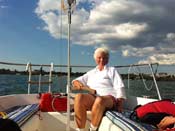
Anchor and Anchoring has its own Terminology

- Anchor Light or Riding Light
- A white light that can be seen all-around and required by maritime law when a boat is at anchor or moored.
- Anchoring
- Mooring a ship to the bottom of a sea or other body of water with an Anchor.
- Anchor Crown
- In a traditional or danforth anchor, the crown is the lowest part of the anchor. It sometimes has a small knob or bump.
- Bitt
- A solid post on deck either at the stern or bow of a ship. Anchor, mooring and towing lines can be attached to it. As in "bitter end"
- Bitter End
- The opposite end to the anchor, of the anchor rode which is hopefully securely attached to the boat. The Bitter end could be attached to the Bitt. Originally bitter end did not mean unhappy end but only the last part of the rode that was attached to the bitt.
- Bow Roller
- These are used to secure the anchor at the bow of the boat. Because the anchor is in position and only needs to be dropped, using a bow roller makes it easier to deploy the anchor.
- Breaking out
- The process of lifting an anchor and breaking it free from the sea bed.
- Cable, cable length
- A measure of length which is a tenth of a nautical mile, about 600 feet, or about 100 fathoms. Originally the length of a ship's anchor cable in the days of the large sailboats.
- Cathead
- A timber which projects from the bow of a vessel and used to support the anchor in traditional vessels. Catting and Fishing was the process of securing the anchor.
- Chain Locker
- Anchoring Chain is stored in a Chain Locker
- Come home
- To drag
- Drogue or Sea Anchor
- Are objects used to control a drifting boat. Sea anchors are often parachute like objects connected to the front of the boat and which slow the drift of a boat. Drogues are dragged behind a boat and help slow down or keep a boat oriented, often during difficult sea conditions. Drogues can be single units or long series of cones tied to the rode.
- Fathom
- A linear measure of 6 feet commonly used to measure depth or the length of anchor rode.
- Fluke
- The broad usually triangular plate on the arm of an anchor
- Ground Tackle
- The anchors, anchor cables, and cable fittings plus the shackles used in anchoring a boat
- Kedge Anchor
- Is a light anchor used as a second anchor on a ship. It is used for Kedging, or also for anchoring in light conditions.
- Kedging
- Also known as warping, it's a method of moving a boat when the boat cannot be sailed or in a calm. The kedge is dropped up wind or up current either with a dinghy or by throwing, and the boat pulled up to the anchor.
- Hawsepipe
- A pipe or moulding in a boats side where the anchor rode fits through the hull.
- Rode
- The vessel is attached to the anchor by the rode which is made of chain, rope, cable, or a combination of these.
- Scope
- The ratio of the length of rode to the water depth
- Up and down
- An anchor chain is said to be up and down when the boat is directly above the anchor and the chain is no longer lying on the bottom.
- To weigh anchor
- To take on the weight of the anchor on the boat, in other words to lift the anchor from the sea floor. Similar to Anchors Aweight (not anchors away!)
- An anchor is broken off the bottom
- When it is lifted off the bottom. Also "broken out"
- Set
- To drop and position an anchor so that it holds
- Changing the NIP of the anchor line
- To prevent wear at the same place the anchor line is occasionally let out or taken in so that chafe is not always on the same spot on the rode.
- Tripping an Anchor
- Sometimes a line is attached to the opposite end from the rode attachment of the anchor. This line is used to pull the anchor out if it is caught or fouled. The tripping line is sometimes attached to a small float which indicates where the anchor is set.
- Horizontal Load
- The force exerted on an anchor by the boat pulling horizontally.
- Vertical Load
- The force exerted on the bow of a boat by the anchor rode.
- Windlass
- A type of winch used on boats to hoist anchors and haul mooring lines.
I try to be accurate and check my information, but mistakes happen.
email me if you find mistakes, I'll fix them and we'll all benefit: Christine
Sea Anchors and Drogues
Carbon Fiber terminology
Nautical Terms about boat hulls
Terms about Sails
GPS and Chartplotter vocabulary and acronyms
Rowing and Rowboat terminology and vocabulary
Useful articles about Drogues and Sea Anchors
The Chain Splice is a useful way of attaching a line to a chain so that it can pass through a windlass without binding.
Radar and Radar reflectors
My page on Brass
Anchor bow roller:
Cheap anchor float, Amazon add-on product:
Cheap anchor float, Amazon add-on product:
Small Print
This information is for general knowledge. I don't suggest that this is the only way or the best way to anchor a boat. Use your head and do your research. Anchoring depends on the conditions as well as the type of anchor.